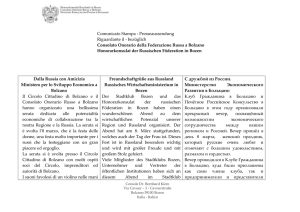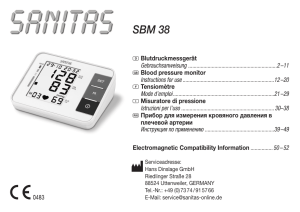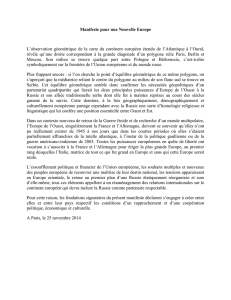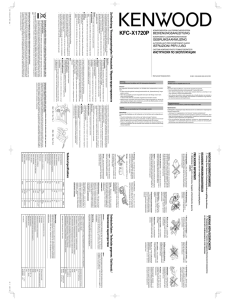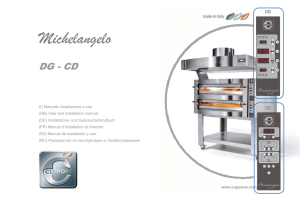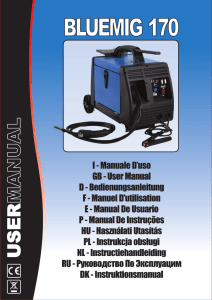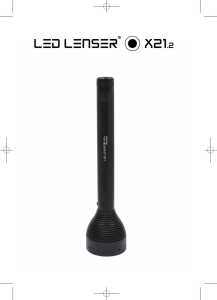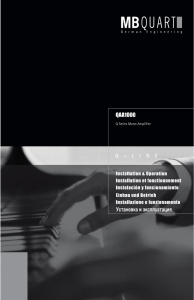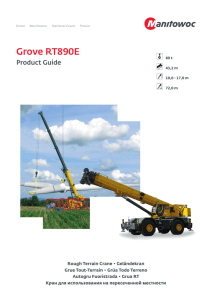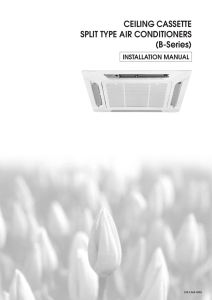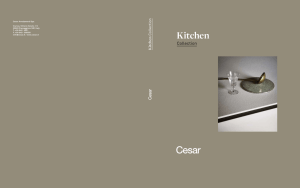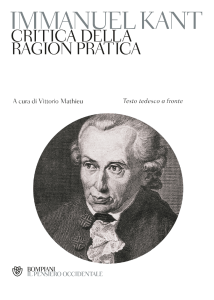informazioni per posa
advertisement
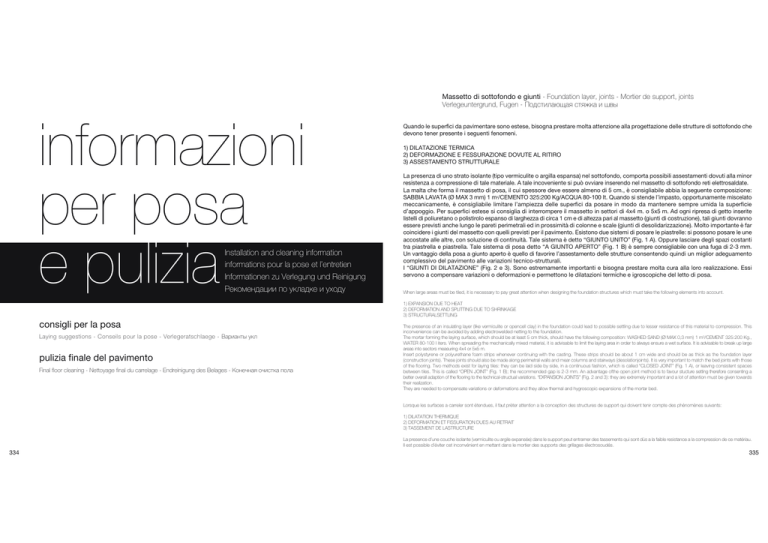
Massetto di sottofondo e giunti - Foundation layer, joints - Mortier de support, joints Verlegeuntergrund, Fugen - Подстилающая стяжка и швы informazioni per posa e pulizia Installation and cleaning information informations pour la pose et l’entretien Informationen zu Verlegung und Reinigung Рекомендации по укладке и уходу Quando le superfìci da pavimentare sono estese, bisogna prestare molta attenzione alla progettazione delle strutture di sottofondo che devono tener presente i seguenti fenomeni. 1) DILATAZIONE TERMICA 2) DEFORMAZIONE E FESSURAZIONE DOVUTE AL RITIRO 3) ASSESTAMENTO STRUTTURALE La presenza di uno strato isolante (tipo vermiculite o argilla espansa) nel sottofondo, comporta possibili assestamenti dovuti alla minor resistenza a compressione di tale materiale. A tale incoveniente si può ovviare inserendo nel massetto di sottofondo reti elettrosaldate. La malta che forma il massetto di posa, il cui spessore deve essere almeno di 5 cm., è consigliabile abbia la seguente composizione: SABBIA LAVATA (Ø MAX 3 mm) 1 m3/CEMENTO 325:200 Kg/ACQUA 80-100 It. Quando si stende l’impasto, opportunamente miscelato meccanicamente, è consigliabile limitare l’ampiezza delle superfici da posare in modo da mantenere sempre umida la superficie d’appoggio. Per superfici estese si consiglia di interrompere il massetto in settori di 4x4 m. o 5x5 m. Ad ogni ripresa di getto inserite listelli di poliuretano o polistirolo espanso di larghezza di circa 1 cm e di altezza pari al massetto (giunti di costruzione), tali giunti dovranno essere previsti anche lungo le pareti perimetrali ed in prossimità di colonne e scale (giunti di desolidarizzazione). Molto importante è far coincidere i giunti del massetto con quelli previsti per il pavimento. Esistono due sistemi di posare le piastrelle: si possono posare le une accostate alle altre, con soluzione di continuità. Tale sistema è detto “GIUNTO UNITO” (Fig. 1 A). Oppure lasciare degli spazi costanti tra piastrella e piastrella. Tale sistema di posa detto “A GIUNTO APERTO” (Fig. 1 B) è sempre consigliabile con una fuga di 2-3 mm. Un vantaggio della posa a giunto aperto è quello di favorire l’assestamento delle strutture consentendo quindi un miglior adeguamento complessivo del pavimento alle variazioni tecnico-strutturali. I “GIUNTI DI DILATAZIONE” (Fig. 2 e 3). Sono estremamente importanti e bisogna prestare molta cura alla loro realizzazione. Essi servono a compensare variazioni o deformazioni e permettono le dilatazioni termiche e igroscopiche del letto di posa. When large areas must be tiled, it is necessary to pay great attention when designing the foundation structures which must take the following elements into account. 1) EXPANSION DUE TO HEAT 2) DEFORMATION AND SPLITTING DUE TO SHRINKAGE 3) STRUCTURALSETTLING consigli per la posa Laying suggestions - Conseils pour la pose - Verlegeratschlaege - Bapиaнты укл pulizia finale del pavimento Final floor cleaning - Nettoyage final du carrelage - Endreinigung des Belages - Конечная очистка пола The presence of an insulating layer (like vermiculite or opencell clay) in the foundation could lead to possible settling due to lesser resistance of this material to compression. This inconvenience can be avoided by adding electrowelded netting to the foundation. The mortar forming the laying surface, which should be at least 5 cm thick, should have the following composition: WASHED SAND (Ø MAX 0,3 mm) 1 m3/CEMENT 325:200 Kg., WATER 80-100 I iters. When spreading the mechanically mixed material, it is advisable to limit the laying area in order to always ensure a wet surface. It is advisable to break up large areas into sectors measuring 4x4 or 5x5 m. Insert polystyrene or polyurethane foam strips whenever continuing with the casting. These strips should be about 1 cm wide and should be as thick as the foundation layer (construction joints). These joints should also be made along perimetral walls and mear columns and stairways (desolationjoints). It is very important to match the bed joints with those of the flooring. Two methods exist for laying tiles: they can be laid side by side, in a continuous fashion, which is called “CLOSED JOINT” (Fig. 1 A), or leaving consistent spaces between tiles. This is called “OPEN JOINT” (Fig. 1 B); the recommended gap is 2-3 mm. An advantage ofthe open joint method is to favour stucture setting therefore consenting a better overall adaption of the flooring to the technical-structual variations. “EXPANSION JOINTS” (Fig. 2 and 3): they are extremely important and a lot of attention must be given towards their realization. They are needed to compensate variations or deformations and they allow thermal and hygroscopic expansions of the mortar bed. Lorsque les surfaces a carreler sont étendues, il faut prèter attention a la conception des structures de support qui doivent tenir compte des phénomènes suivants: 1) DILATATION THERMIQUE 2) DEFORMATION ET FISSURATION DUES AU RETRAIT 3) TASSEMENT DE LASTRUCTURE La presence d’une couche isolante (vermiculite ou argile expansée) dans le support peut entramer des tassements qui sont dùs a la faible resistance a la compression de ce matériau. Il est possible d’éviter cet inconvénient en mettant dans le mortier des supports des grillages électrosoudés. 334 335 Massetto di sottofondo e giunti - Foundation layer, joints - Mortier de support, joints Verlegeuntergrund, Fugen - Подстилающая стяжка и швы Sigillante plastico - Plastic cement Plastique de scellement Kunststoffhaltige Fugmasse Пластиковый герметик Materiale ceramico - Ceramic tile Matériel céramique Keramikmaterial Керамический материал Materiale di tamponamento non deteriorabile Non-deteriorating pluggin material Matériel de tamponnement inaltérable Fäulnisbeständiges Dichtungsmaterial Неразрушающийся заполнитель Strato legante - Binding layer Couche liante - Bindeschicht Вяжущий слой Struttura grezza - Rough frame Structure brute - Rohstruktur Необработанная структура Massetto di sottofondo e giunti - Foundation layer, joints - Mortier de support, joints Verlegeuntergrund, Fugen - Подстилающая стяжка и швы При наличии полов большой площади, необходимо уделять большое внимание проектированию подстилающих слоев с учетом следующих явлений. 1) ТЕПЛОВОЕ РАСШИРЕНИЕ 2) ДЕФОРМАЦИЯ И РАСТРЕСКИВАНИЕ, ВЫЗВАННЫЕ УСАДКОЙ 3) СТРУКТУРНОЕ ОСЕДАНИЕ Наличие в подстилающем слое изоляции (типа вермикулит или керамзит) влечет за собой возможное оседание, вызванное меньшей прочностью данного материала на сжатие. Этот недостаток можно устранить включением электросваренных сеток в подстилающую стяжку. Рекомендуется, чтобы раствор, образующий стяжку для укладки толщиной не менее 5 см, имел следующий состав: ПРОМЫТЫЙ ПЕСОК (МАКС. диам. 3 мм) 1 м3, ЦЕМЕНТ 325:200 кг, ВОДА 80-100 л. При укладке смеси, после ее надлежащего механического смешивания, рекомендуется ограничивать площадь обрабатываемых поверхностей, с тем, чтобы опорная поверхность была всегда влажной. В случае больших поверхностей рекомендуется разделить стяжку на квадраты размером 4x4 м или 5x5 м. При продолжении заливки уложите рейки из пенополиуретана или поролона шириной около 1 см и высотой, равной высоте стяжки (технологические швы). Такие швы необходимо предусмотреть также вдоль наружных стен и вблизи колонн и лестниц (разделительные швы). Очень важно, чтобы швы стяжки совпадали со швами, предусмотренными для пола. Укладка плитки осуществляется двумя способами: плитка может укладываться друг рядом с другом, это так называемый “ЗАКРЫТЫЙ ШОВ” (Рис. 1 A). Или же между плитками можно оставить определенное расстояние, это так называемый способ укладки “С ОТКРЫТЫМ ШВОМ” (Рис. 1 B), для которого рекомендуется зазор в 2-3 мм. Преимущество укладки с открытым швом состоит в том, что она способствует оседанию структур, обеспечивая в целом лучшую общую адаптацию пола к технико-структурным изменениям. “РАСШИРИТЕЛЬНЫЕ ШВЫ” (Рис. 2 и 3) имеют большое значение, и их выполнению необходимо уделять большое внимание. Они компенсируют изменения или деформацию, а также обеспечивают тепловое и гигроскопическое расширение рабочей поверхности кладки. Polistirolo - Polystyrene Polystyréne - Polystirol Полистирол a) giunto di dilatazione - expansion joint - Joint de dilatation Dehnungsfuge - расширительный шов Le mortier de pose formant la couche liante, dont l’epaisseur doit ètre d’au moins 5 cm, doit avoir la composition suivante: SABLE LAVEE(Ø MAX. 3 mm) 1 m3/CIMENT 325: 200 Kg/EAU 80 a 100 litres. Lors de la pose du mélange, brassé mécaniquement, il est conseillé de limiter l’étendue des surfaces a couvrir afin que la surface d’appui soit toujours numide. Pour des surfaces étendues, il est conseillé de subdiviser le mortier en secteurs de 4x4 ou 5x5 m. A chaque reprise de la coulée, intercaler des listeis en polyurethane ou polystyrene expansé d’une largeur d’environ 1 cm et d’une hauteur égale a celle de la couche de mortier (joints de construction); il faudra prévoir ces joints mème le long des parois périmétrales et a proximité de colonnes et d’escaliers (joints de désolidarisation). Il est très important de faire coincider le joint du mortier avec ceux prévus pour le pian portant. Il existe deux systèmes de poser les carreaux: les uns a còte des autres, avec des solutions de continuile - système appelé “JOINT NUL” (Fig. 1 A) - et avec un espace régulier entre les carreaux - système appelé “AVEC JOINT” (Fig. 1 B). Il est conseillé, dans ce dernier, de toujours laisser un interstice de 2 a 3 mm. Un des avantages de la pose avec joint est de favoriser le tassement des structures, ce qui permet d’obtenir une meilleure adaptation globale du plancher aux variations technico- structurelles. Les “JOINTS DE DILATATION” (Fig. 2 et 3) sont extrèmement importants et leur réalisation exige une grande attention. lls servent a compenser les variations et les déformations et permettent les dilations thermiques et hygroscopiques du lit de pose. b) giunto di desolidarizzazione - separating joint - Joint à désolidariser - Trennfuge - разделительный шов Wenn die mit Fliesen zu belegenden Flachen sehr groß sind, ist besonders auf die richtige Vorbereitung des Untergrunds zu achten. Dabei sind folgende Faktoren zu beräcksichtigen: e) giunto strutturale - structure joint - Joint de structure Strukturfuge - структурный шов c) giunto di ritiro-fiessione - shrinkage-flexure joint - Joint de retrait-flexion - Schwindungs-verzugsfuge усадочно-изгибный шов d) giunto di costruzione - construction joint - Joint de construction - Konstruktionsfuge - строительный шов 1) WÄRMEAUSDEHNUNG 2)VERFORMUNG UND SPALTBILDUNG DES UNTERGRUNDES 3) STRUKTURELL BEDINGTE SETZERSCHEINUNGEN Ist im Untergrund eine Schicht mit isolierenden Eigenschaften vom Typ Vermikulit oder Blahton) vorhanden, sind die geringere Bestandigkeit dieses Baustoffes hinsichtiich seiner Belastbarkeit und damit die wahrscheinlich verbundenen Setzerscheinungen zu berücksichtigen. Dies kann durch das Einlegen von verschweißten Drahtnetzen in den Estrich ausgeglichen werden. Der Untergrund aus Zementestrich solite eine Mindeststarke von 5 cm haben. Die folgende Zusammensetzung ist ratsam: GEWASCHENER SAND (Ø MAX. 3 mm) 1 m3/ZEMENT 325: 200 Kg / WASSER 80/100 1. Wenn die Zementmischung aufgebracht wird, nachdem sie mechanisch gemischt wurde, solite die Verlegeflache beschränkt werden, urn immer eine noch feuchte Auflageflache zur Verfugung zu haben. Fùr größere Raume solite derVerlegeuntergrund in Sektoren von 4x4 oder 5x5 Meter aufgeteilt werden, wobei man zwischen die einzeinen Estrichabschnitte Leisten aus Polyurethan- oder Polystyrolschaum einfùgt, die etwa 1 cm breit und so hoch wie der Estrich sein sollen (Konstruktionsfugen). Diese Fugen mussen auch entlang der Raumwande und urn Säulen und Treppen herum angelegt werden (Trennfugen). Sehr wichtig ist dann, daß die Estrichfugen mit den Belagfugen zusammenfallen. Die Fliesen können auf zweierlei Arten verlegt werden: sie kònnen kontinuierlich aneinander angelegt werden, was als “VERBUNDFUGE”bezeichnet wird (Abb. 1A), oder aber zwischen den Fliesen werden gleichmäßige Zwischenraumegelassen. Bei dem letzterem Verlegesystem mit “HOHLFUGE” (Abb. 1 B) empfiehit sich eine Fuge von 2-3 mm. Die Hohiverfugung hat den Vorteil, daß das Setzen der Strukturen begunstigt wird und der boden sich somit besser den technisch-strukturellen Veranderungen anpassen kann. Besonders wichtig sind die “DEHUNGSFUGEN” (Abb. 2 und 3), die mit größter Sorgfalt durchzuführen sind. Sie haben die Aufgabe, Variationen und Deformationen auszugleichen und ermòglichen die thermische und hygroskopiche Ausdehung des Verlegungsbettes. 336 337 Posa in opera - Laying - Mise en oeuvre - Verlegevorgang - Укладка Stuccatura delle fughe - Grouting the joints - Scellement des joints Das Verfugen - Заделка швов Il pavimento può essere posato a cemento (posa tradizionale) o con collanti. 1) Nel caso di posa tradizionale, questa avviene come per un normale pavimento ceramico, adottando alcuni accorgimenti: - Non si deve immergere il materiale in acqua prima della posa; - Bisogna aumentare lo spolvero in cemento nella quantità di 5±8 Kg/m2; - Battere il pavimento con l’apposita macchina fino alla fuoriuscita del cemento liquido dalle fughe. 2) Nel caso di posa con collanti, che noi consigliamo, si procede con l’uso di collanti a base cementizia o organica, con l’aggiunta di additivi lattici resinosi: - Preparazione della superficie di appoggio: renderla perfettamente piana, senza fessurazioni e ben pulita. - Preparazione del collante: omogeneizzare il tutto meccanicamente o manualmente, lasciando riposare per circa 10-15 minuti. - Applicazione del collante e posa: applicare con l’apposita spatola dentata eseguendo campi di posa ridotti; applicare le piastrelle con una pressione superficiale; effettuare qualche distacco di piastrelle per controllare l’adesione. The flooring can be laid either traditionally with cement or with adhesive. 1) In the event of traditional laying, this will be achieved in the same way as a normal ceramic floor by adapting certain expedients: - The material should not be immersed in water before laying; - The cement dusting must be increased to 5-8 Kg/m2; - Tap the floor with the appropriate device until liquid cement escapes from the gaps. 2) When laying with adhesives, which is preferable, we recommend, using cement-based or organic adhesives with the addition of resinous latex additives: - Preparing the subsurface thoroughiy: ensure that it is perfectiy fiat, without cracks and well cleaned. - Preparing the adhesive: mix all ingredients mechnically or by hand, leaving to stand for about 10-15 minutes. - Applying the adhesive and laying the tiles: spread with a special notched spreader over small areas; apply the tiles by pressing on the surface: try to detach a few tiles to check adhesion. Le carrelage peut ètre pose en utilisant du ciment ou des colles. 1) En cas de pose traditionnelle, procèder comme pour un carrelage céramique ordinaire en adoptant quelques précautions: - Ne pas immerger le matériau dans l’eau avant la pose; - Augmenter le poudrage en ciment dans une quantité de 5 a 8 Kg/m2; - Battre le sol a l’aide de la machine prévue a cet effet jusqu’à faire sortir le ciment liquido par les joints. 2) Dans le cas de pose avec des colles, que nous conseillons, avec l’utilisation de colles a base de ciment ou organique, avec l’ajout d’additifs lactiques et résineux: - Préparation de la surface d’appui: la rendre parfaitement piane, sans fissures et bien propre. - Préparation de la colle; homogénéiser le tout mécaniquement ou normalement, en laissant reposer pendant environ 10-15 minutes. - Application de la colle et pose: appliquer a l’aide d’une spatule speciale dentée, en exécutant des eténdues de pose réduites; appliquer les carreaux avec une pression superficielle effectuer quelques décollements de carreaux afin de vérifier l’adhérence. Die Fliesen können auf traditionelle Art mit Zementmörtel als Bettungsmaterial oder mit kunststoffvergiltetem Klebemörtel befestigt werden. 1) Bei traditionellen Verfahren ist wie bei allen anderen keramischen Belägen vorzugehen, wobei aber beachtet werden muss, dass die Fliesen vor der Verlegung nicht mit Wasser durchtränkt werden und dass das Pudern mit Zement auf 5-8 Kg/m2 zu erhöhen ist. Nach dem Einlegen der Platten sollten diese mit einer dazu vorgesehenen Maschine angekiopft werden,bis seitlich flussiger Zement austritt. 2) Vorzuziehen ist aber sicherlich die Verlegung mit Klebemörtel, wir empfehien die Verwendung von kunststoffvergiltetem Klebemörtel aufZementbasis. Vorbereitung des Untergrunds: der Untergrund darf keine Unebenheiten aufweisen und muss grundiich gesaubert werden.Vorbereitung des Klebers: den Kleber mechanisch oder manuell zu einer homogenen Masse vermischen und 10-15 Minuten ruhen lassen. Auftragen des Klebers und Verlegung: den Kleber mit einem gezahnten Spachtel auf kleinere Flächen auftragen, die Fliesen verlegen und leicht andrücken. Zur Kontrolle des Haftvermögens einige Fliesen Iòsen. В первом случае плитка укладывается как обычная керамическая плитка для полов, без погружения в воду перед укладкой, увеличив дозу цемента до 5-8 кг/м2, с усадкой плитки при помощи специальной машины до выхода цемента из швов. В случае укладки плитки на клеящие вещества, что мы рекомендуем, использовать вещества на цементной или органической основе с добавками компонентов из латекса и смол. Поверхность пола должна быть абсолютно плоской, без щелей и хорошо очищена. Клеящий состав должен перемешиваться вручную или при помощи специального оборудования и выдерживаться на протяжении 10-15 минут. Данное клеящее вещество наносится специальным зубчатым шпателем на небольшие пространства. Плитку следует накладывать и прижимать, а также попробовать сорвать несколько плиток, чтобы проверить и закрепление на поверхности. Bisogna premettere che nella preparazione dello stucco devono essere rispettati i dosaggi di acqua (e/o lattice), senza eccedere nella diluizione, e che gli stucchi devono essere scelti anche in base alla granulometria in funzione dell’ampiezza della fuga che si intende realizzare. Dopo la stuccatura con stucchi cementizi (per gli epossidici la procedura è completamente diversa e si rimanda al nostro manuale on line ed ai manuali del produttore) si attende un tempo relativamente breve che va dai pochi minuti a poche ore a seconda delle condizioni climatiche, fino a quando lo stucco opacizza (in gergo si dice “tira”) quindi si procede con la rimozione meccanica degli eccessi di stucco tramite spugna ben pulita e leggermente umida, dopo di che si attende un paio di giorni circa prima di procedere alla prima pulizia. La stuccatura della fuga dovrà avvenire il giorno seguente la posa. Le fughe dovranno essere perfettamente pulite in tutto il loro spessore, quindi bisogna bagnare accuratamente con spugna il sottofondo e il bordo delle piastrelle. La stuccatura e la fuga può essere eseguita con stucchi pronti presenti in commercio. La stuccatura delle fughe si effettua normalmente con spatole di gomma “a zero” facendo penetrare bene in profondita lo stucco. Si lascia asciugare il tutto e quando il sigillante inizia a far presa, si procede ad asportare l’eccesso con una spugna umida. N.B.: È da sconsigliarsi l’uso di sabbia o segatura che scava ed asporta la boiacca ancora fresca dalle fughe, così come sconsigliamo l’uso di stucchi colorati che, se non rimossi in tempi opportuni, possono lasciare dei depositi sulle piastrelle difficilmente rimovibili. Per maggiori dettagli consultate, sul nostro sito all’indirizzo www.caesar.it, il capitolo “Manuali” nella sezione “Area tecnica”. It is necessary to take into consideration that, while preparing the grout, the dosage of water (and/or latex) must strictly follow the instructions without diluting it excessively and that grouts must be selected according to their granulometry and depending on the width of the grout lines. After grouting using cement grouts (for epoxy grouts the procedure is totally different therefore please consult our on-line hand-book or that of the manufacturer), it is necessary to wait for a short period of time, ranging from a few minutes to a few hours depending on weather conditions, until the grout becomes opaque, then it is possible to proceed with the removal of excess grout using a clean and slightly wet sponge. After a period of around 48 hours, the first cleaning of the entire tiled surface can be carried out. The grouting of the joints must be done the day after the laying. The joints must be completely clean throughout their entire body. The underside and edges of the tile must be carefully soaked. The grouting and the jointing must be performed with prepared grout found on the market. The joints are normally grouted with rubber spatulas, letting the grout penetrate the depths. Everything is left to dry. When the sealant starts to take hold, the excess should then be removed with a wet sponge. N.B.: It is not advised to use sand or sawdust that digs into and removes the grout that is still fresh from the joints. We also advise against the use of coloured grouts that, if not removed in the appropriate amount of time, can leave deposits on the tiles that are difficult to remove. For more detailed information, consult the “Manual” in the “Technical Area” at www.caesar.it. Nous devons rappeler avant tout que dans la préparation des joints, les dosages d’eau ( et/ou de latex ) doivent être respectés, sans dilution excessive, et que les joints doivent être choisis sur la base de la granulométrie et en fonction de la grandeur du joint à réaliser. Après le jointoiement réalisé avec des joints ciments ( pour les joints époxydiques la procédure est tout à fait différente, veuillez consulter notre notice en ligne et les notices du producteur ), il faut attendre un délai plutôt bref qui va de quelques minutes à quelques heures en fonction des conditions climatiques pour que le joint devienne opaque ( on dit qu’il “tire” ) et on peut alors procéder à l’élimination mécanique du joint excédentaire avec une éponge bien propre et légèrement humide, après quoi il faut attendre quelques jours avant de procéder au premier nettoyage. Le masticage du joint inter-carreaux devra être effectué un jour après la pose. Les joints inter-carreaux doivent être parfaitement nettoyés dans toute leur épaisseur et il faudra donc mouiller soigneusement le support et le bord des carreaux à l’aide d’une éponge. Le masticage et le jointement peuvent être effectués à l’aide de stucs prêts à l’emploi en vente dans le commerce. Le masticage des joints inter-carreaux s’effectue normalement à l’aide de spatules en caoutchouc “ à zéro ” en faisant bien pénétrer le stuc en profondeur. Laisser sécher le tout. Lorsque le scelleur commence à sécher, éliminer le stuc en trop à l’aide d’une éponge humide. N.B.: nous conseillons l’utilisation de sable ou de sciure qui creuse et élimine le coulis encore frais des joints inter-carreaux et déconseillons l’usage de stucs colorés qui, au cas où ils ne seraient pas enlevés à temps, peuvent laisser sur les carreaux des dépôts difficiles à éliminer. Pour de plus amples détails, consulter le chapitre “ Manuels ” à la section “ Zone technique ” sur notre site à l’adresse www.caesar.it. 338 339 Stuccatura delle fughe - Grouting the joints - Scellement des joints Das Verfugen - Заделка швов Beim Anrühren des Fugenmörtels ist das Verhältnis von Wasser (und /oder Latex), ohne dabei übermäßig zu verdünnen, zu beachten. Die Körnung des Mörtels sollte entsprechend der Weite der Fugen, die zu bearbeiten sind, ausgesucht werden. Nach der Verfugung mit Zementmörtel (für Epoxidmörtel ist die Behandlung eine völlig andere, wir verweisen daher auf unsere online-Anleitung und auf die Gebrauchshinweise des Herstellers) sollte, je nach klimatischen Gegebenheiten, kurze Zeit, d.h. von einigen Minuten bis zu ein paar Sekunden, gewartet werden bis der Fugenmörtel matt wird (in der Fachsprache sagt man auch „anzieht“), erst dann entfernt man mit einem sauberen, feuchten Schwamm vorsichtig den überschüssigen Fugenmörtel. Die erste Reinigung ist nach ein paar Tagen durchzuführen. Die Fugenabdichtung muss am Tag nach der Verlegung erfolgen. Da die Fugen über die gesamte Stärke einwandfrei sauber sein müssen, Untergrund und Ränder der Fliesen mit reichlich Wasser und einem Schwamm befeuchten. Die Verkittung und Verfugung kann mit im Handel erhältlichen Fertigklebern vorgenommen werden. Die Fugenabdichtung erfolgt normalerweise mit auf Null ausziehbaren Gummispachteln, wobei der Kitt fest und tief eingearbeitet wird. Lassen Sie alles trocknen, und sobald das Versieglungsmittel zu erhärten beginnt, den Überschuss mit einem feuchten Schwamm entfernen. Anmerkung: Nicht empfehlenswert ist der Einsatz von Sand oder Sägemehl, die den noch weichen Mörtel aus den Fugen reiben, ebenso unratsam sind farbige Fugenmassen, die, falls nicht rechtzeitig entfernt, auf den Fliesen schwer zu beseitigende Ablagerungen zurücklassen könnten. Für nähere Details lesen Sie auf unserer Internetseite www.caesar.it das Kapitel “Handbücher” in der Sektion “Technischer Bereich”. Прежде всего отметим, что при подготовке затирочного раствора необходимо соблюдать пропорции, добавляя только строго необходимое количество воды (или латекса), и что фракция материала подбирается с учётом желаемой ширины шва. После заполнения швов затирками на цементной основе (в случае эпоксидных затирок соблюдается иная процедура; см. наши инструкции он-лайн или инструкции производителя) выжидают от нескольких минут до нескольких часов, в зависимости от условий среды, до лёгкого схватывания раствора, а затем приступают к удалению излишков материала чистой влажной губкой. Спустя примерно два дня выполняют первую чистку. Заделка швов должна выполняться на следующий день после укладки плитки. Швы должны быть тщательно очищены по всей их толщине, следовательно, необходимо тщательно протереть губкой стыки и края плитки. Заделка швов должна выполняться раствором, состоящим из 60% цемента и 40% песка, замешанных на воде. С помощью резинового шпателя. Раствор вдавливается внутрь шва. Далее швы необходимо высушить, а когда раствор начнёт схватываться, следует удалить излишки влажной губкой. Не рекомендуется использовать для этих целей песок или опилки, так как их механическое воздействие приводит к удалению из швов ещё сырого раствора. Также не рекомендуется использование цветных заполнителей; последние могут оставить трудно выводимые пятна, если они не были смыты в течение установленного времени. Минимальный рекомендуемый шов равен 3 мм. 340 Pulizia finale del pavimento - Final foor cleaning - Nettoyage final du carrelage Endreinigung des Belages - Конечная очистка пола Dopo 36/48 ore, quando sia il pavimento sia le fughe hanno terminato la prima fase di asciugatura e non è ancora iniziata la vera e propria stagionatura è fondamentale procedere al lavaggio della superficie pavimentata utilizzando un acido ad azione tamponata diluito secondo quanto indicato sulle etichette delle confezioni. Per situazioni critiche ripetere l’operazione almeno due volte aumentando la percentuale di acqua. I residui sporchi di stucco devono essere rimossi senza lasciarli asciugare, risciacquando abbondantemente con acqua pulita cambiando spesso l’acqua di risciacquo e asportando sempre quella sporca. Particolare cura deve essere usata per i prodotti incisi, levigati e antisdrucciolo; per questi ultimi l’utilizzo di una spazzolatura, tipo lavapavimenti, in unione con l’azione acida aiuta ad arrivare in tutti gli interstizi della struttura facilitandone la pulizia. Se tale lavaggio non viene effettuato o effettuato tardivamente i residui di stucco che hanno creato un film cementizio estremamente assorbente, tendono a trattenere lo sporco facilitando la sporcabilità della superficie che può poi diventare difficile da pulire completamente: in questi casi Ceramiche CAESAR S.p.A. declina ogni responsabilità. Ricordiamo che il gres porcellanato è un prodotto le cui caratteristiche consentono di ottenere i massimi livelli di resistenza meccanica, all’usura, agli acidi e alle basi, caratteristiche a cui si aggiungono valori estetici di particolare rilievo. Non essendo un prodotto smaltato il gres porcellanato mantiene un minimo assorbimento, e ciò costituisce la caratteristica intrinseca del prodotto. Nella produzione CAESAR, come indicato nella scheda tecnica, detto assorbimento è contenuto nei valori minimi assoluti e quindi per tutte le utilizzazioni dei nostri prodotti saranno raggiungibili i migliori risultati di impiego specifico. La manutenzione ordinaria dovrà essere fatta con prodotti detergenti specifici per rimuovere sporco e macchie purchè non siano ceranti, filmanti o pellicolanti. Consideriamo il risciacquo con acqua pulita fondamentale per un ottima operazione di pulizia, per cui sconsigliamo l’utilizzo di prodotti con l’indicazione “non occorre il risciacquo”. Prodotti in tinta unita chiara, ed in particolare il bianco e l’extrabianco, soprattutto nella versione levigata e lappata, pur essendo sempre pulibili dal punto di vista igienico, sono relativamente delicati rispetto a taluni tipi di macchia poiché, a volte, le stesse possono lasciare tracce o aloni più visibili che su prodotti meno chiari. Occorre pertanto tener presente che questi prodotti richiedono una manutenzione più impegnativa per la pulizia. I prodotti PUREWHITE, LUX rispondono alla normativa vigente UNI EN ISO 14411 Annex G 10545-14 (determinazione della resistenza alle macchie) valida per materiali di prima scelta in termini di pulibilità: macchie particolari di sporco necessitano di una pulizia straordinaria con detergenti specifici per il tipo di macchia. Si fa presente però che le norme citate non prevedono la pulibilità di tracce di gomma (scarpe, tacchi, tappi di sedie ecc.) in particolare negli ambienti dove tali fenomeni sono maggiormente possibili e ripetitivi: pertanto su tali prodotti Ceramiche CAESAR S.p.A. declina ogni responsabilità. Vi invitiamo a richiedere la nostra scheda relativa ai consigli di manutenzione ordinaria e straordinaria, o a consultare il nostro sito web nella sezione tecnica. After 36/48 hours, when both the floor and the grouts have completed their first drying phase and before the real phase of the floor has yet to begin, it is necessary to proceed with the cleaning of the tiled surface using a “padding” action acid detergent, diluted according to the manufacturer’s instructions. For areas heavily stained with grout, it is necessary to repeat this operation once or twice, increasing the percentage of water. The excess grout residue must be removed so that it does not dry and stick on the surface. It is necessary to change the cleaning water frequently and rinse well. Care must be taken on inlayed, polished and anti-slip products; for the latter in particular, the use of a floor-washing machine combined with the action of an acid detergent helps reach the spaces between adjacent tiles and clean them properly. If such a cleaning procedure is not carried out, or if such cleaning is carried out too late, the grout residue creates an extremely absorbent film, which holds dirt, making the surface difficult to clean: in this case, Ceramiche CAESAR S.p.A. will not be liable for any damage caused to the surface. We would like to remind you that porcelain stoneware is a product with excellent technical features which allow for the highest grade of mechanical wear and resistance to acid and alkaline, features which are added to a high aesthetic quality. Porcelain stoneware is not glazed, therefore it has a low absorption level, another intrinsic characteristic of the product. As detailed in the technical sheets, absorption levels are very low in the production process CAESAR adopts, and all our products will achieve the best results for any kind of specific application. Ordinary maintenance must be carried out using specialist detergents to remove stains but these detergents must not leave a wax, film or membrane residue. Rinsing well with plenty of clean water is a fundamental part of the cleaning procedure, therefore we advise against the use of products which state that they “do not need rinsing”. Bright coloured products, in particular white and extra-white tiles, especially those with a polished and honed finish, are very delicate and, although for all intent and purpose are hygienically clean, they tend to stain more easily than darker tiles. It is therefore necessary to remember that these particular products require careful maintenance. PUREWHITE, LUX products meet the UNI EN ISO 14411 Annex G 10545-14 standard (calculation of stain resistance), for top quality materials in terms of cleanability: certain types of dirt need an extra-ordinary maintenance procedure using specific detergents according to the type of stain. We would like to inform you that, the above mentioned standards do not cover rubber stains (shoes, heels, mats, etc...) especially where these kinds of stains are frequent: therefore, Ceramiche CAESAR S.p.A. will not be held liable for any such damage to the surface of these products. We invite you to request our technical sheet indicating recommendations for ordinary and extra-ordinary maintenance, or to consult the technical section on our website. 341 Pulizia finale del pavimento - Final foor cleaning - Nettoyage final du carrelage Endreinigung des Belages - Конечная очистка пола Après 36/48 heures, quand tant le sol que les joints ont terminé la première phase de séchage mais avant que ne commence la véritable dessiccation, il est fondamental de laver la surface carrelée en ayant recours à un acide à action tamponnée dilué suivant les indications de l’étiquette d’emballage. Dans les situations critiques, répéter cette opération au moins deux fois en augmentant la proportion d’eau. Les déchets résiduels de joint doivent être ôtés avant qu’ils ne soient secs, par un abondant rinçage à l’eau propre au cours duquel l’eau de rinçage sera changée régulièrement et l’eau sale, éliminée. Un soin particulier doit être apporté aux produits gravés, polis et antidérapants. Pour ces derniers, le recours à un brossage pour le lavage des sols, combinée à l’action acide aide à atteindre tous les interstices de la structure et en facilite le nettoyage. Si ce lavage n’a pas lieu, ou s’il s’effectue trop tard, les résidus de joint qui créent une pellicule ciment extrêmement absorbante ont tendance à retenir les souillures et à faire en sorte que la surface se salisse plus vite et, par la suite, peuvent rendre plus difficile le nettoyage complet. Dans ce cas, Ceramiche CAESAR S.p.A. décline toute responsabilité. Nous rappelons que le grès cérame est un produit dont les caractéristiques permettent d’obtenir les meilleurs niveaux de résistance mécanique à l’usure, aux acides et aux bases et auxquelles s’ajoutent des valeurs esthétiques d’intérêt particulier. Ne s’agissant pas d’un produit émaillé, le grès cérame conserve une absorption minimum qui constitue la caractéristique intrinsèque du produit. Comme l’indique la fiche technique, dans la production Caesar, cette absorption est maintenue aux minimas absolus, ce qui signifie que pour n’importe quelle utilisation de nos produits, les résultats atteints seront les meilleurs pour cet emploi spécifique. L’entretien ordinaire doit s’effectuer avec des détergents spécifiques afin d’ôter le sale et les taches pour autant qu’il ne s’agisse pas de produits cirant, de pelliculant ou de produits créant une couche. Nous estimons que le rinçage à l’eau propre est fondamental pour un bon nettoyage, c’est pourquoi non déconseillons d’utiliser les produits qui « ne nécessite aucun rinçage ». Bien que les produits de teinte claire unie, le blanc et l’extra-blanc en particulier, surtout dans la version polie et “lappato”, soient lavables d’un point de vue hygiénique, ils sont relativement délicats à certains types de taches car il en est qui peuvent laisser des traces ou des auréoles qui se voient plus que sur les produits moins clairs. Il faut donc se souvenir que le nettoyage de ces produits demande plus d’effort pour l’entretien. Les produits PUREWHITE, LUX sont conformes à la norme en vigueur UNI EN ISO 14411 Annex G 10545-14 ( Détermination de la résistance aux taches ) valables pour les matériaux de premier choix en ce qui concerne leur capacité à être nettoyés. Certaines taches sales requièrent qu’un nettoyage extraordinaire soit effectué avec des détergents spécifiques pour ce type de taches. Nous attirons votre attention sur le fait que les normes citées n‘incluent pas le nettoyage des traces de caoutchouc ( chaussures, talons, pieds de chaises ) en particulier pour les espaces où ces phénomènes sont plus probables et fréquents : c’est pourquoi Ceramiche CAESAR S.p.A. décline toute responsabilité sur ces produits. Nous vous invitons à demander notre fiche conseil pour l’entretien ordinaire et extraordinaire et à consulter la section technique de notre site web. Nach 36/48 Stunden, nachdem sowohl Fußboden als auch Fugen die erste Phase der Trocknung hinter sich haben und das eigentliche Abtrocknen noch nicht begonnen hat, ist es wichtig die Bodenoberfläche mit einem Reiniger auf Puffersäurebasis, welcher nach Angabe auf dem Verpackungsetikett verdünnt wird, nachzuwischen. Bei schwierigen Umständen den Vorgang mindestens zwei Mal unter Zugabe von mehr Wasser wiederholen. Die Mörtelrückstände sind unverzüglich und mit reichlich Wasser, das häufig gewechselt werden sollte, zu entfernen. Besondere Sorgfalt bedarf es bei geritzten, geschliffenen und rutschfesten Produkten; die letzteren sollten zur Erleichterung mit einer Bürste zusammen mit säurehaltigem Reinigungsmittel gereinigt werden, damit man auch in die Zwischenräume und Ritzen gelangt. Wird diese Reinigung nicht oder nur unzureichend durchgeführt bilden die Rückstände einen Zementfilm mit hoher absorbierender Eigenschaft und neigen dazu den Schmutz zurückzuhalten. Damit wird es immer schwieriger die Oberfläche vollständig und gründlich zu säubern: in diesen Fällen übernimmt Ceramiche CAESAR S.p.A. keine Haftung. Unsere Feinsteinzeugprodukte zeichnen sich durch höchste mechanische Beständigkeit gegen Verschleiß, Säuren und Basen, sowie durch bedeutende ästhetische Werte aus. Da es sich hier um nicht glasiertes Feinsteinzeug handelt verfügt das Produkt über eine minimale Absorption, was eine dem Produkt selbst innewohnende Eigenschaft darstellt. In der Produktion bei CAESAR liegt, wie auf dem technischen Datenblatt angegeben, die besagte Absorption bei den absoluten Tiefstwerten, so daß mit unseren Produkten im jeweiligen Einsatzbereich die besten Resultate erzielt werden können. Die normale, einfache Pflege sollte mit speziellen Reinigern und Fleckenentfernen, die kein Wachs beinhalten oder Filme und Schleier hinterlassen, durchgeführt werden. Das Nachspülen mit sauberem Wasser ist für eine optimale Reinigung unerlässlich, daher raten wir vom Gebrauch von Produkten mit der Angabe: “kein Klarspülen erforderlich“ ab. Obwohl die hellen einfarbigen Produkte, dabei im Besonderen die weißen und extraweißen- vor allem in der geschliffenen und polierten Ausführung - hygienisch zu reinigen sind, erweisen sie sich gegenüber einigen Arten von Flecken als relativ empfindlich. Diese hinterlassen auf ihnen hin und wieder sichtbare Spuren oder Ränder. Achten Sie daher darauf, daß diese Produkte besonders sorgfältig und regelmäßig gereinigt werden. Die Produkte PUREWHITE, LUX entsprechen der geltenden europäischen Norm UNI EN ISO 14411 Annex G 10545-14 (Bestimmung der Fleckenbeständigkeit), gültig für Materialien erster Wahl in Bezug auf die Reinigung: besondere Flecken erfordern eine Behandlung und Reinigung mit - je nach Art der Flecken - speziellen Fleckenreinigern. Wir weisen jedoch darauf hin, daß die angegebenen Normen sich nicht auf die Reinigung und Entfernung von Gummispuren(von Schuhen, Absätzen, Stühlen etc. ), vor allem in Ambienten in denen diese Phänomene häufiger und wiederholt auftreten, beziehen: daher übernimmt Ceramiche CAESAR S.p.A. für diese Produkte keine Haftung. Fordern Sie einfach unsere Ratschläge und Empfehlungen für die normale und die außerordentliche Pflege an oder sehen Sie auf unserer Internetseite unter ‚technische Rubrik‘ nach. 342 Pulizia finale del pavimento - Final foor cleaning - Nettoyage final du carrelage Endreinigung des Belages - Конечная очистка пола Через 36/48 часов, когда пол и швы высохли, но не окончательно, необходимо промыть облицованную поверхность кислотным средством буферного действия, разведённым согласно указаниям на этикетке или упаковке. В критических ситуациях указанную операцию выполняют не менее двух раз, увеличивая процентное содержание воды. Удаляйте разводы или остатки затирки до их высыхания, прополаскивая обильным количеством воды и часто меняя воду. Особенно внимательно следует выполнять чистку гравированных, полированных и противоскользящих плиток. Уборку последних может облегчить использование поломоечной машины, которая обеспечивает проникновение кислотного средства во все канавки или щели. Если данная чистка не производится или производится с запозданием, то оставшийся на поверхности облицовки тонкий слой цементной затирки будет способствовать лёгкому впитыванию грязи и, следовательно, повышенной загрязняемости; к тому же вполне вероятно, что поверхность больше не сможет быть очищена полностью. В этом случае Ceramiche CAESAR S.p.A. снимает с себя всякую ответственность. Напоминаем, что керамогранит – материал, обладающий высочайшей механической прочностью, износостойкостью, устойчивостью к воздействию кислот и оснований, а также незаурядными эстетическими качествами. Однако неглазурованный керамогранит сохраняет минимальную поглощающую способность: это естественная характеристика материала. Изделия CAESAR, как видно из перечня технических характеристик, обладают самым низким коэффициентом водопоглощения, поэтому гарантируют отличные эксплуатационные показатели во всех условиях применения. Для ухода рекомендуется применение специальных чистящих средств, способных удалять грязь и пятна, при этом нельзя использовать средства на восковой основе или образующие защитную плёнку. Оптимальная чистка пола предполагает полоскание чистой водой, поэтому избегайте применения средств, не требующих ополаскивания. Следует учесть, что на однотонных светлых плитках, и в особенности на белых и экстрабелых или полированных, определённые типы загрязнений, более заметны, чем на менее светлых изделиях. По этой причине уход за такими плитками требует больших усилий. Средства PUREWHITE, LUX соответствуют требованиям стандартов UNI EN ISO 14411, Приложение G, 1545-5 (определение стойкости к образованию пятен) в отношении изделий первого сорта. Некоторые типы загрязнений требуют экстренной чистки с применением специфических для конкретных пятен препаратов. Обращаем внимание на то, что указанные стандарты не рассматривают возможность удаления следов резины (от подошвы обуви, каблуков, резиновых наконечников стульев и т.п.), в частности, в помещениях, где подобные явления наиболее вероятны. Поэтому Ceramiche CAESAR S.p.A. отклоняет всякую ответственность в связи с этим. Советуем запросить в нашей компании рекомендации по текущему и экстренному уходу или посетить технический раздел нашего сайта. 343 Stuccatura e prima pulizia Serie More Scratched e Flow Miniscratched - Grouting and first cleaning operations for the More Scratched Series and Flow Miniscratched - Jointoiement et premier nettoyage Série More Scratched et Flow Miniscratched - Verfugung und erste reinigung der Serie More Scratched und Flow Miniscratched - EЗаделка швов и первая очистка плитки Серии More Scratched, Flow Miniscratched Stuccatura e prima pulizia Serie More Scratched e Flow Miniscratched - Grouting and first cleaning operations for the More Scratched Series and Flow Miniscratched - Jointoiement et premier nettoyage Série More Scratched et Flow Miniscratched - Verfugung und erste reinigung der Serie More Scratched und Flow Miniscratched - Заделка швов и первая очистка плитки Серии More Scratched, Flow Miniscratched 1. TIPI DI STUCCO: Per la stuccatura delle fughe della Serie MORE SCRATCHED e FLOW MINISCRATCHED 30x60 si consiglia di utilizzare stucco cementizio per fughe migliorate (CLASSE CG2 secondo EN 13888) senza l’aggiunta di alcun additivo. Si sconsiglia inoltre l’utilizzo di malte a base di resine reattive (CLASSE RG secondo EN 13888). 2. ELIMINAZIONE DELLO STUCCO IN ECCESSO: Operazione fondamentale e necessaria al fine di evitare una manutenzione ordinaria troppo onerosa. - Togliere l’eccesso di stucco dalla superficie, muovendo la spatola diagonalmente alle fughe, a impasto ancora fresco. - Pulire il residuo di stucco solo quando diventa opaco, normalmente dopo 10-20 minuti, con una spugna umida di cellulosa dura, lavorando in diagonale alle fughe; rispettare questi tempi in quanto le fughe potrebbero essere svuotate parzialmente se pulite troppo presto. Se la stuccatura dovesse essere già indurita, è necessario utilizzare una spugna abrasiva in schotch-brite inumidita con acqua pulita. 3. PULIZIA DI FINE CANTIERE. A 36 – 48 ore dalla stuccatura, procedere ad una pulizia acida attenendosi scrupolosamente ai consigli di seguito riportati. 3.1. PRODOTTI CONSIGLIATI. Si consiglia di utilizzare una soluzione acido-solvente ad azione tamponata, tipo CAESAR 1, diluita al 50% in acqua possibilmente calda. Evitare assolutamente l’utilizzo di acidi da ferramenta diluiti (per il loro rilascio di fumi nocivi e per la loro azione “bruciante” nei confronti dei giunti). 3.2. MODALITA’ DI ESECUZIONE. 1.Bagnare il rivestimento affinché lo stucco cementizio venga protetto da una eventuale azione corrosiva della soluzione acida diluita. 2.Distribuire uniformemente la soluzione acida diluita utilizzando una spugna commerciale schotch-brite. 3.Lasciare agire per qualche minuto, in funzione dell’intensità dello sporco. 4.Intervenire energicamente con spazzola con setole in nylon o similari. 5.Raccogliere il residuo con stracci asciutti e puliti. 6.Risciacquare abbondantemente con acqua calda pulita, ripetendo l’operazione anche più volte sino alla eliminazione di qualsiasi alonatura o residuo negli interstizi. Qualora rimanessero zone non perfettamente pulite, ripetere il lavaggio acido con CAESAR 1 puro. 4. Brush vigorously with a brush with nylon or similar bristles. 5. Soak up residual solution with clean and dry cloths rags. 6. Rinse with plenty of hot clean water, and repeat this operation several times until all stains or residues in the grooves have been removed. Should there still be areas that are not perfectly clean, repeat the washing procedure using undiluted CAESAR 1 acid. 1. TYPE OF GROUT For grouting joints of tiles of the Series MORE SCRATCHED and FLOW MINISCRATCHED 30X60, we recommend the use of cement-based grout to improve the appearance of the joints (CLASS CG2 according to EN 13888) without additives. We advise you not to use mortar with a reactive resin base (CLASS RG according to EN 13888). 2. REMOVING EXCESS GROUT This operation is essential and necessary to prevent troublesome and costly routine maintenance. - Remove excess grout from the surface, by moving the spatula diagonally with respect to the joints, when the mixture is still wet. - Clean away residues of grout only when this becomes opaque, generally after 10-20 minutes, using a wet hard cellulose sponge, working diagonally with respect to the joints; these operations must be performed at the time indicated: you could otherwise risk partially ‘emptying’ the joints if the grout is too wet. If the grout has already hardened, clean using an abrasive Scotch-Brite sponge moistened in clean water. 3. CLEANING AFTER INSTALLATION At 36 - 48 hours from grouting, perform the acid cleaning operations, following the instructions provided below. 3.1 RECOMMENDED PRODUCTS We recommend the use of an acid-solvent solution with a buffered action of the CAESAR 1 type, diluted in 50% of warm water. Never use diluted acids that are too aggressive (they release harmful fumes, and can also “burn” the grout in the joints). 3.2 HOW TO PROCEED 1. Wet the tiled surface to protect the cement-based grout against the corrosive action of the diluted acid solution. 2. Evenly spread the diluted acid solution using a standard Scotch-Brite sponge. 3. Let the solution work for a few minutes, depending on how difficult the dirt is. 344 1. PRODUIT DE JOINTOIEMENT PRECONISE Pour le remplissage des joints de la Série MORE SCRATCHED et FLOW MINISCRATCHED 30X60, il est conseillé d’utiliser un produit à base de ciment pour joints améliorés (CLASSE CG2 selon EN 13888) sans l’ajout d’aucun additif. Il est aussi conseillé d’utiliser un mortier à base de résines réactives (CLASSE RG selon EN 13888). 2. ELIMINATION DU PRODUIT DE JOINTOIEMENT EN EXCES Cette opération est fondamentale et nécessaire afin de prévenir un entretien ordinaire trop coûteux. - Eliminer l’excès de produit de jointoiement du carrelage en passant la brosse diagonalement aux joints, lorsque le produit est encore frais. - Nettoyer le résidu de produit seulement après que le produit soit devenu opaque, c’est à dire généralement après 10-20 minutes, avec une éponge humide en cellulose dure qui doit être passée diagonalement par rapport aux joints. Ce délai doit absolument être respecté, car les joints pourraient être vidés partiellement s’ils sont nettoyés trop tôt. Si le jointoiement devait déjà avoir pris, il faudrait utiliser une éponge abrasive en Scotch-brite® imbibée avec de l’eau propre. 3. NETTOYAGE FIN DE POSE A 36 - 48 heures du jointoiement, procéder à un nettoyage acide en respectant scrupuleusement les conseils reportés ci-dessous. 3.1. PRODUITS PRECONISES Il est conseillé d’utiliser une solution acide - solvantée à action tamponnée, comme CAESAR 1, diluée à 50% dans de l’eau chaude de préférence. Il est absolument interdit d’utiliser des produits corrosifs dilués (en raison d’émanation de fumées toxiques et pour leur action corrosive sur les joints). 3.2. MODALITE D’EXECUTION 1.Mouiller le carrelage afin de protéger le produit de jointoiement à base de ciment contre une éventuelle action corrosive de la solution acide diluée. 2.Distribuer uniformément la solution acide diluée avec une éponge de la marque Scotch-brite® que l’on trouve dans le commerce. 3.Laisser agir pendant quelques minutes en fonction de l’intensité de la saleté. 4.Nettoyer énergiquement avec une brosse en soies de Nylon ou similaires. 5.Receuillir le résidu avec des chiffons propres et secs. 6.Rincer abondamment avec de l’eau chaude propre, en répétant l’opération plusieurs fois jusqu’à l’élimination de toute auréole ou résidu dans les interstices. Si malgré tout, il devait subsister des zones imparfaitement propres, répéter le lavage acide avec CAESAR 1 pur. 1. FUGENMASSE Für das Verfugen der Serie MORE SCRATCHED und FLOW MINISCRATCHED 30X60 empfiehlt sich die Verwendung von Zementstuck für verbesserte Fugen (KLASSE CG2 gemäß EN 13888) ohne die Zugabe von Zusatzstoffen. Außerdem empfiehlt sich die Verwendung von Mörtel auf Reaktionsharzbasis (KLASSE RG gemäß EN 13888). 2. ENTFERNEN DER ÜBERSCHÜSSIGEN FUGENMASSE Wesentlicher und unerlässlicher Vorgang, um eine allzu beschwerliche Wartung in Zukunft zu vermeiden. - Die überschüssige Fugenmasse von der Oberfläche entfernen, wobei die Spachtel diagonal zur Fuge agieren sollte, wenn die Fugenmasse noch frisch ist. - Die restliche Fugenmasse erst dann entfernen, wenn diese opak geworden ist, was normalerweise nach 10-20 Minuten der Fall ist; dazu einen feuchten Schwamm aus hartem Zellstoff verwenden und diagonal zur Fuge arbeiten; die Zeitangabe sollte eingehalten werden, da die Fugen teilweise geleert werden könnten, wenn zu früh gereinigt wird. Ist die Fugenmasse bereits hart geworden, muss ein mit sauberem Wasser angefeuchteter Schotch-brite-Scheuerschwamm verwendet werden. 3. REINIGUNG BEI ARBEITSENDE 36 - 48 Stunden nach dem Verfugen, ist eine Säurereinigung durchzuführen, wobei die nachfolgend angeführten Hinweise strengstens einzuhalten sind. 345 Stuccatura e prima pulizia Serie More Scratched e Flow Miniscratched - Grouting and first cleaning operations for the More Scratched Series and Flow Miniscratched - Jointoiement et premier nettoyage Série More Scratched et Flow Miniscratched - Verfugung und erste reinigung der Serie More Scratched und Flow Miniscratched - Estucado y primera limpieza Serie More Scratched y Flow Miniscratched 3.1 EMPFOHLENE PRODUKTE Es empfiehlt sich die Verwendung einer Säurelösung mit Pufferwirkung, Typ CAESAR 1, zu 50% mit möglichst warmem Wasser verdünnt. Unbedingt zu vermeiden ist die Verwendung von verdünnten Metallwarensäuren (wegen der Abgabe von schädlichen Dämpfen und wegen ihrer “brennenden” Wirkung gegenüber der Fugen). 3.2 VORGEHENSWEISE 1. Die Oberfläche anfeuchten, damit die Fugenmasse vor einer eventuellen Korrosionswirkung der verdünnten Säurelösung geschützt wird. 2. Die verdünnte Säurelösung gleichmäßig mit einem im Handel erhältlichen Schotch-brite-Schwamm verteilen. 3. Einige Minuten lang einwirken lassen, abhängig von der Schmutzintensität. 4. Energisch mit einer Bürste mit Borsten aus Nylon o.ä. vorgehen. 5. Rückstände mit trockenen und sauberen Lappen entfernen. 6. Mit reichlich sauberem, warmem Wasser spülen, auch mehrmals, bis alle Rückstände vollständig entfernt sind. Sollten dennoch nicht hundertprozentig saubere Bereiche verbleiben, ist die Säurereinigung mit CAESAR 1 pur zu wiederholen. 1. ТИП ЗАТИРКИ Для заделки швов плитки серии MORE SCRATCHED, FLOW MINISCRATCHED 30X60 рекомендуется использовать улучшенную цементную затирку (КЛАССА CG2 согласно EN 13888) без каких-либо добавок. Кроме того, не рекомендуется использовать растворы на основе реактивных смол (КЛАССА RG согласно EN 13888). 2. УДАЛЕНИЕ ИЗЛИШКОВ ЗАТИРКИ Это важная и необходимая операция для того, чтобы избежать слишком дорогого повседневного ухода. Удалите излишки затирки с поверхности, перемещая шпатель в диагональном направлении относительно швов, пока смесь еще не затвердела. Очистите остатки затирки только тогда, когда они станут матовыми, что обычно бывает через 10-20 минут, используя влажную губку из жесткой целлюлозы и проводя ею в диагональном направлении относительно швов. Соблюдайте это время, так как если чистить швы слишком рано, то можно частично удалить затирку. Если затирка уже отвердела, то необходимо воспользоваться абразивной губкой из материала schotch-brite, смоченной в чистой воде. 3. ЧИСТКА В КОНЦЕ РАБОТ НА СТРОЙПЛОЩАДКЕ Через 36 - 48 часов после заделки швов выполните кислотную очистку, тщательно выполняя приведенные ниже рекомендации. 3.1. РЕКОМЕНДУЕМЫЕ СРЕДСТВА Рекомендуется использовать раствор кислоты-растворителя буферного действия, например средство CAESAR 1, разбавляя его на 50% водой, желательно горячей. Ни в коем случае не применяйте разбавленные кислоты для травления металла (потому что они выделяют вредные испарения и “сжигают” швы). 3.2. СПОСОБ ВЫПОЛНЕНИЯ 1. Смочите поверхность для того, чтобы защитить цементную затирку от возможной коррозии разбавленного кислотного раствора. 2. Равномерно распределите разбавленный кислотный раствор при помощи имеющейся в продаже губки типа schotch-brite. 3. Выдержите несколько минут, в зависимости от степени загрязнения. 4. Энергично обработайте щеткой с нейлоновыми или сходными щетинами. 5. Соберите остатки при помощи сухих и чистых тряпок. 6. Промойте большим количеством чистой, горячей воды, повторяя операцию несколько раз до удаления любых разводов или остатков в щелях. Если не все участки очистились, повторите кислотную промывку при помощи средства CAESAR 1 в чистом виде. 346 Suggerimenti di pulizia e manutenzione - Cleaning and maintenance suggestions - Suggestions pour le nettoyage et l’entretien - Reinigungs- und Wartungsvorschläge - Рекомендации по чистке и уходу NUOVO CAESAR 1 - Detergente a base acida, consigliato dopo la posa a pavimento per la pulizia decalcificante e la normale manutenzione, in quanto detergente specifico allo scopo. - A detergent with an acid basis, specifically recommended after bath gloor or wall laying, for the decalcioficant cleaningand the regular maintenance. - Détergent à base d’acide, conseillé après la pose sur sol et mur, pour la nettoyage décalcifiant et l’entretien normal, en tant que détergent specifique dans ce cas. - Reinigungsmittel auf Saürebasis für die erste Grundeinigung nach der Verlegung, Erdacht für die Enftfernung von anorganischer Verschmutzung (z.B Zementschleier). - Моющее средство на кислотной основе, рекомендуется после укладки пола для декальцифицирования и для нормального ухода, оно специально разработано для этих целей. NUOVO CAESAR 2 - Prodotto alcalino per grès porcellanato, adatto per qualsiasi tipo di sporco e particolarmente indicato per la rimozione di grassi animali e vegetali. - A limited foam type product for for degreasing and general cleaning, suitable for all types of stains but especially for remove of vegetable and animals fats. - Produit peu mousseux pour le dégraissage et le nettoyage des sols, particulièrement indiqué pour l’elimination de graisses animales ou végétales. - Reinigungsmittel auf Laugenbasis für jegliche Verschmutzungsart, insbesondere aber solche organischer Herkunft, wie tierische oder pflanziche Fette. - Щелочное средство для фарфорового керамогранита, пригодное для любого типа загрязнения, особенно рекомендуется для удаления животного и растительного жира. NUOVO M3 - Prodotto idrorepellente, impregnante, particolarmente indicato per superfici levigate. - Sealer, water and oil repellent product, particulary suitable for polished surfaces. - Produit hydrofuge particulièrement conseillé pour les carreaux polis. - Imprägnierungsmittel auf Silikonbasis für poliertes Feinsteinzeug. - Водоотталкивающее, пропиточное средство, особенно подходящее для шлифованных поверхностей. 347 TIPO DI SPORCO TYPE OF STAIN TYPE DE SALETE VERSCHMUTZUNGSART íàè áÄÉêüáçÖçàü SOLUZIONE SOLUTION CLEANING SOLUTION êÄëíÇéê DETERGENTI DETERGENTS REINIGUNG åéûôàÖ ëêÖÑëíÇÄ DITTA PRODUTTRICE DETERGENTE SOCIETE PRODUCTRICE DE DETERGENT MANUFACTURER REINIGUNGSMITTEL HERSTELLERFIRMA îàêåÄ-àáÉéíéÇàíÖãú åéûôÖÉé CPEÑCTBA Suggerimenti di pulizia e manutenzione - Cleaning and maintenance suggestions - Suggestions pour le nettoyage et l’entretien - Reinigungs- und Wartungsvorschläge - Рекомендации по чистке и уходу MACCHIE INORGANICHE - INORGANIC STAINS - TACHES INORGANIQUES - ANORGANISCHE FLECKEN - OPÉAHàóECKàE èüTàA Cemento-Cement-Ciment-Zement-ñÂÏÂÌÚ Carbone-Carbon-Charbon-Kohle-ì„Óθ Effluorescenze calcaree-Calcium Efflorescence Efflorescenses calcaires-Kalk-Effloreszenzen-àÁ‚ÂÒÚÍÓ‚˚ ÔflÚ̇ Gesso-Chalk-Plâtre-Gips-ÉËÔÒ Residui metallici-Metallic residues Résidus Métalliques-Metallreste-ëΉ˚ ÏÂڇη Ruggine-Rust-Rouille-Rost-Herrumbre Stucco cementizio-Cement-based grout Stuc de ciment-Zementmörtel-ñÂÏÂÌÚ̇fl ¯Ô‡Í΂͇ Stucco colorato-Coloured grout-Stuc coloré-Farbiger Kitt-ñ‚ÂÚ̇fl ¯Ô‡Í΂͇ Tempere murali-Wall paint-Détrempes murales-Mauerfarben ä‡Ò͇ ‰Îfl ÒÚÂÌ NUOVO CAESAR 1 acida acid acid sãurehalting äËÒÎoÚÌ˚È FILADEK Ceramiche Caesar S.p.a. - Spezzano di Fiorano (MO) tel. 0536.817111 Fila - via Garibaldi 32, 35137 Padova tel. 049.9467300 KERANET (liquido - liquid liquide - flussing - ÊˉÍÓÒÚ¸) Mapei - via Cafiero 22, 20158 Milano tel. 02.39320283 SERVICE SOLVACID Geal Chimica - via Settala 21, 51031 Agliana (PT) - tel. 0574.679715 MACCHIE ORGANICHE - ORGANIC STAINS - TACHES ORGANIQUES - ORGANISCHE FLECKEN - éêÉÄçàóÖëäàÖ èüíçÄ Coca Cola-äÓ͇-ÍÓ· Gelato, Caffè, Vino, Birra-Ice Cream, Coffee, Wine, Beer Glace, Café, Vin, Bière-Eis,Kaffee,Wein,Bier åÓÓÊÂÌÓÂ, ÍÓÙÂ, ‚ËÌÓ, ÔË‚Ó Grassi animali-Animal fats-Graisses animales-Tierische Fette ÊË‚ÓÚÌ˚ ÊË˚ Grassi vegetali-Vegetable fats-Graisses végétales-Pflanzliche Fette ‡ÒÚËÚÂθÌ˚ ÊË˚ Mostarda, MaioneseMustard,mayonnaise-Moutard, MayonnaiseSenf,Mayonnaise-ÉӘˈ‡, χÈÓÌÂÁ Ketch-up, Marmellata-Ketchup,Jam-Ketchup,Confiture Ketchup,Marmelade-äÂÚ˜ÛÔ, ‚‡Â̸ Olio di lino, Rossetto, Cera-Linseed oil,lipstick,wax Huile de lin, Rouge à lèvres, Cire-Leinöl,Lippenstift,Wachs NUOVO CAESAR 2 alcalina e neutra alkaline and neutral alcaline et neutre alkalihaltig und neutral ˘ÂÎÓ˜ÌÓÈ Ë ÌÂÈڇθÌ˚È N/124 ÒÓ΂ÓÈ ‡ÒÚ‚Ó Fila - via Garibaldi 32, 35137 Padova - tel. 049.9467300 Fila - via Garibaldi 32, 35137 Padova - tel. 049.9467300 SERVICE ALCALE Geal Chimica - via Settala 21, 51031 Agliana (PT) tel. 0574.679715 Ipoclorito di sodio(candeggina per capi di bucato bianco) sodium hypochloride(bleach for white laundry) - Hypochlorite de sodium (eau de javel pour lessive de blanc)-Natronbleichlauge (Bleicher für weiße Wäsche) Гипохлорит натрия (отбеливатель для белья) SERVICE SOLVENTE Olii siliconati-Silicone oils-Huiles siliconées-Silikonöle-ëËÎËÍÓÌÓ‚˚ χÒ· Olii meccanici-Machine oil-Huiles mécaniques-Mechaniköle 凯ËÌÌ˚ χÒ· Resine e smalti-Resins and glazes-Résines et émaux-Harze und LacksëÏÓÎ˚ Ë ˝Ï‡ÎË Catrame e caucciù-Coal and natural rubber-Goudron et caoutchouc-Teer und Kautschuk-ÉÛ‰ÓÌ Ë Í‡Û˜ÛÍ Inchiostri e lampostil-Inks and markers-Encres et feutres-Tinte und Faserschreiber-óÂÌË· Ë ÙÎÓχÒÚÂ˚ Pneumatico-Tire-Pneu-Pneumatisch-òË̇ Silicone e chewin-gum - Silicone and chewin-gum - Silicone et chewin-gum Silikon und Kaugummi - ëËÎËÍÓÌ Ë Ê‚‡ÚÂθ̇fl ÂÁËÌ͇ solvente solvent solvant Lösungsmittel solvente Kimax - via Crema 67, Bagnolo Cremasco (CR) - tel. 0373.648610 FILACLEANER ÄååàÄä soluzione salina saline solution solution saline Salzlösung Scati s.r.l. - via Radici in Piano Sassuolo (MO) - tel. 0536.804239 PS87 Ammoniaca - Ammonium Ammoniac - Ammoniak ã¸ÌflÌÓ χÒÎÓ, ÔÓχ‰‡, ‚ÓÒÍ ALONI RESIDUI di natura organica RESIDUAL RINGS of organic nature AUREOLES RESIDUELLES de nature organique SCHMUTZRÄNDER organischer Natur Остатки органического характера CHESTERTON 815 Ceramiche Caesar S.p.a. - Spezzano di Fiorano (MO) tel. 0536.817111 Universale - Universal Universel - Universell - ìÌË‚Â҇θÌ˚È Universale - Universal Universel - Universell - ìÌË‚Â҇θÌ˚È Geal Chimica - via Settala 21, 51031 Agliana (PT) - Tel. 0574.679715 FILASOLV Fila - via Garibaldi 32, 35137 Padova - tel. 049.9467300 Acetone - Aceton - Acetona - ĈÂÚÓÌ Universale - Universal - Universel - Universell - ìÌË‚Â҇θÌ˚È DILUENTE NITRO - NITRO -THINER DILUANT NITRO -NITROVERDÜNNER Universale - Universal - Universel - Universell - ìÌË‚Â҇θÌ˚È çàíêéêÄëíÇéêàíÖãú ACQUARAGIA - TURPENTINE TEREBENTHINE - TERPENTIN ëäàèàÑÄê Universale - Universal - Universel - Universell - ìÌË‚Â҇θÌ˚È TRIELINA - TRICHLORETHYLENE TRICHLORÉTHYLÈNE - TRICHLORÄTHYLEN íêàùãàç Universale - Universal - Universel - Universell - ìÌË‚Â҇θÌ˚È CIF AMMONIACAL Universale - Universal - Universel - Universell - ìÌË‚Â҇θÌ˚È PASTA LAVAMANI - HAND CLEANSER PATE LAVE-MAINS - HANDWASCHPASTE JABÓN DE PASTILLA PARA LAS MANOS Universale - Universal - Universel - Universell - ìÌË‚Â҇θÌ˚È ghiaccio + spatola - ice+scraper glace+spatule - Eis+spachtel Ή+¯Ô‡ÚÂθ N.B: Nell’utilizzo dei prodotti sopraelencati si raccomanda di seguire le istruzioni d’uso indicate sulle confezioni. - When using the above products, the instructions on the package should be followed. - Lors de l’utilisation des produits susmentionnés, il est recommandé de suivre les instructions pour l’emploi indiquées sur les emballages. - Bei der Verwendung der oben angeführten Produkte sollten Sie sich an die Gebrauchsanweisungen auf der Packung halten. - èêàå.: èË ËÒÔÓθÁÓ‚‡ÌËË ‚˚¯ÂÔ˜ËÒÎÂÌÌ˚ı ËÁ‰ÂÎËÈ ÂÍÓÏẨÛÂÚÒfl ÒΉӂ‡Ú¸ ËÌÒÚÛ͈ËflÏ, Û͇Á‡ÌÌ˚Ï Ì‡ ÛÔ‡ÍÓ‚ÍÂ. 348 AVVERTENZA I suggerimenti illustrati in precedenza sono frutto di ricerca, verifica di laboratorio ed esperienza pluriennale. Tuttavia le caratteristiche di pulibilità dei materiali variano in modo significativo per le diverse modalità d’installazione, condizioni d’uso, tipologie di superfici e ambiente. In linea generale, all’aumentare delle caratteristiche di antiscivolosità delle piastrelle aumentano le difficoltà di pulizia. L’operatore professionale incaricato dell’intervento di manutenzione e pulizia dovrà sempre procedere ad una preliminare verifica empirica (possibilmente su una porzione di materiale non posato) per ogni singolo tipo di intervento. In caso di condizioni d’uso particolarmente gravose (ad esempio, officine meccaniche o ambienti con forte presenza di residui oleosi e tracce di pneumatico), di errata installazione o di pulizie effettuate in modo inadeguato, Caesar declina ogni responsabilità in merito all’efficacia delle operazioni di pulizia e manutenzione. Resta inteso che Caesar non può essere ritenuta responsabile per eventi, danni o difetti dovuti ad errata installazione, negligente pulizia e manutenzione, o inadeguata scelta della tipologia dei materiali installati e degli adesivi utilizzati con riguardo alla destinazione. WARNING The above suggestions are a result of research, laboratory tests and several years’ experience. However, the cleaning features of the materials may vary significantly according to the different installation methods, conditions of use, types of surface and destination. As a general rule, the higher the anti-slip values of the tiles are, the greater cleaning inconveniences may arise. The professional operator in charge of maintenance and cleaning shall always check the surface condition before proceeding with any cleaning and/or maintenance operation (we would suggest to test some tiles before installation). Caesar declines any liability with reference to cleaning and maintenance operations in case of heavy conditions of use (such as mechanical workshop or spaces presenting oily residues or tyre marks), bad installation work or wrong cleaning operations, it is agreed that Caesar shall not be liable for any event, damage or defect due to wrong installation of the tiles, faulty cleaning and maintenance operations or inadequate choice of the type of material to be laid or of the adhesives used in a certain destination of use. AVERTISSEMENT Les suggestions ci-dessus reportées sont le résultat d’une expérience qui s’étend sur plusieurs années de recherches et de vérifications en laboratoire. Toutefois, les caractéristiques de nettoyabilité des carreaux varient considérablement en fonction des différentes modalités de pose, des conditions d’utilisation, ainsi que de la finition de surfaçage et des locaux. En général, le nettoyage devient plus difficile au fur et à mesure qu’augmente la capacité antidérapante et anti-glissante du carreau. Le responsable chargé de l’entretien et du nettoyage devra toujours procéder au préalable à une vérification empirique (si possible sur une quantité de matériel non posée ) pour toute sorte d’intervention. En cas de conditions d’utilisation particulièrement dures (comme par exemple: ateliers de mécanique ou en présence consistante de résidus huileux et traces de pneus), d’une pose non correcte ou de nettoyages inappropriés et non adéquats, Caesar décline toute responsabilité quant à l’efficacité des opérations de nettoyage et d’entretien. Il reste entendu que Caesar ne pourra être en aucun cas retenue responsable pour des dommages ou défauts dû à une pose non correcte, à un nettoyage inapproprié ou à un entretien négligent, ainsi qu’au choix inadéquat du type de produit posé et des matériaux de pose utilisés par rapport à la destination du produit. ANMERKUNG Die vorher dargestellten Anregungen basieren auf Forschungsergebnisse, Laboruntersuchungen und langjährigen Erfahrungen. Jedoch variiren bedeutend die ReinigungsCharakteristiken des Materiales bei den diversen Verarbeitungen, Nutzungsbedingungen, Oberflächentypologien sowie Ambiente. Für gewöhnlich nimmt mit den Rutschsicherheitseigenschaften der Fliesen der Schwierigkeitsgrad der Säuberung zu. Der ausgebildete Handwerker, der mit der Wartung und Säuberung betraut wird, sollte stets vor jedem Arbeitsbeginn einen Probeversuch (möglichst auf einem kleinen Stück nicht verlegten Materials) durchführen. Bei schwierigen Einsatzbereichen z. B. Kfz-Werkstätten oder in Bereichen mit starker Ölverschmutzung und Reifenspuren, bei falscher Verarbeitung oder bei unsachgemäßer Reinigung weist Caesar jegliche Verantwortung in Bezug auf die Wirksamkeit der Reinigung und Wartung zurück. Es versteht sich, daß Caesar nicht für Ereignisse, Schäden oder Mängel belangt werden kann, die durch unsachgemäße Verarbeitung, durch nicht durchgeführte Reinigung und Wartung oder durch falsche Auswahl der verwendeten Materialien sowie durch Einsatz ungeeigneter Klebstoffe verursacht werden. ПРЕДУПРЕЖДЕНИЕ Проиллюстрированные выше рекомендации являются плодом лабораторных исследований и многолетнего опыта. Степень очищаемости материалов варьирует в зависимости от способа укладки, от условий эксплуатации, от типа поверхности и среды. Обычно чем выше сопротивляемость плиток скольжению, тем труднее их чистить. Профессиональные работники, занимающиеся обслуживанием и чисткой, перед выполнением любого типа операций должны осуществить практическую проверку материала (желательно на неуложенном изделии). В случае особо тяжёлых условий эксплуатации (например, в автомастерских или в помещениях, где часто образуются масляные пятна или остаются следы шин), а также в случае неправильной укладки или неправильно выполненной послеукладочной чистки Caesar снимает с себя любую ответственность относительно эффективности последующих действий по чистке и уходу. Компания Caesar равным образом не несёт ответственности за происшествия, ущерб или дефекты, обнаружившиеся по причине неправильной укладки и чистки, небрежного обслуживания или ошибочного – по отношению к функциональному назначению – выбора типа изделий и клея. 349
